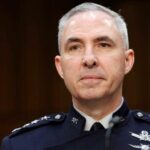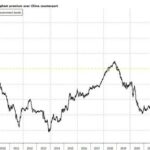

The cost of goods and services rose 0.4 percent for a second consecutive month in September, challenging the view that the Federal Reserve’s rate hikes are still bringing down inflation.
The personal consumption expenditure price index was expected to cool slightly from the prior month.
Over the past year, the index is up 3.4 percent. That is unchanged from the August reading, data from the Commerce Department showed Friday. The Federal Reserve says it wants to bring PCE inflation down to two percent, a rate not seen since President Joe Biden took office in early 2021.
The persistence of inflation at the current level casts doubt on the Fed’s claims that the series of rate hikes from March 2022 through July of 2023 are still pulling down inflation. On Thursday, the Commerce Department said the economy grew at an annual pace of 4.9 percent, much faster than expected. That rate of growth is likely inconsistent with falling inflation or the claim that the stance of monetary policy is significantly restrictive.
The PCE price gauge hit a high of 0.9 percent on a month-to-month basis in June of 2022, the fastest clip of price gains since 2005. On a year-over-year basis, the PCE price index increased 7.1 percent in June 20222, the worst inflation since 1981.
The monthly pace of price gains fell from 0.6 percent in January of this year to 3.1 percent in February, a welcome respite from the prior year’s wave of high inflation that was taken as a sign that the Fed’s monetary tightening was wringing price pressures out of the economy. For the following five months, monthly inflation bounced around in a range of three to one percent. In August, however, price gains jumped back up to 0.4 percent, raising concerns that the effect of the Fed’s rate hikes might have diminished.
The core PCE price index, which excludes food and energy prices, rose 0.3 percent, the fastest rate of core price inflation since April. That was a big increase from the 0.1 percent rise in August but in line with expectations. The 12-month gain came in at 3.7 percent, as expected and down from 3.8 percent in the prior month.y
The increase in inflation is unlikely to force Fed officials to raise interest rates at their monetary policy meeting next week. Officials have signaled that they are likely to keep rates unchanged at the 5.25 to 5.50 percent range set back in July. If inflation continues at this rate, however, it could put pressure on the Fed to raise its benchmark target at the following meeting in December.
After the September meeting of the Federal Open Market Committee, the Fed released a summary of the economic projections of officials that showed the median expectation of officials was for 12-month PCE inflation to fall to 3.3 percent by the end of the year and core PCE inflation to be 3.7 percent. The projections indicated that officials do not expect inflation to fall to the two percent target until late 2025 or early 2026.
Service-sector prices rose by 0.5 percent in September, the most since January. Services excluding shelter and energy, a measure frequently cited by Fed chairman Jerome Powell and other Fed officials as a key indicator of inflation, rose 0.4 percent, up from 0.1 percent in the prior month. Compared with a year ago, this so-called “super core” inflation measure is up 4.2 percent.
Prices for goods increased 0.2 percent, defying predictions that goods prices could fall or stop rising as consumers shift spending toward services. Food prices increased 0.3 percent and energy prices increased 1.7 percent. Compared with a year ago, goods prices are up 0.9 percent. Food prices are up 2.7 percent. Energy prices are still slightly below levels hit last summer, registering a year-over-year decrease of 0.1 percent.






